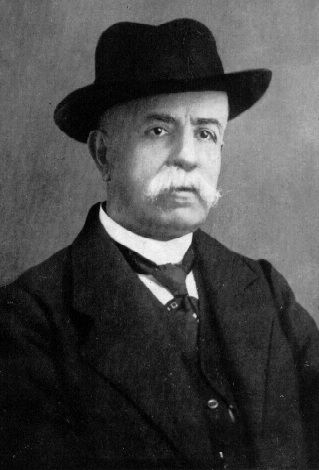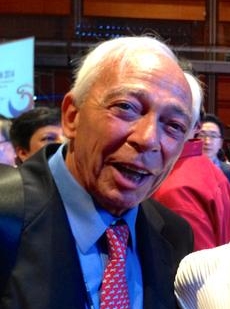
Tullio Levi-Civita, was an Italian mathematician, most famous for his work on absolute differential calculus and its applications to the theory of relativity, but who also made significant contributions in other areas. He was a pupil of Gregorio Ricci-Curbastro, the inventor of tensor calculus. His work included foundational papers in both pure and applied mathematics, celestial mechanics, analytic mechanics and hydrodynamics.

Gregorio Ricci-Curbastro was an Italian mathematician. He is most famous as the discoverer of tensor calculus.

Ennio De Giorgi, a member of the House of Giorgi, was an Italian mathematician who worked on partial differential equations and the foundations of mathematics.

Renato Caccioppoli was an Italian mathematician, known for his contributions to mathematical analysis, including the theory of functions of several complex variables, functional analysis, measure theory.

Gaetano Fichera was an Italian mathematician, working in mathematical analysis, linear elasticity, partial differential equations and several complex variables. He was born in Acireale, and died in Rome.

Antonio Signorini was an influential Italian mathematical physicist and civil engineer of the 20th century. He is known for his work in finite elasticity, thermoelasticity and for formulating the Signorini problem.
Aizik Isaakovich Vol'pert was a Soviet and Israeli mathematician and chemical engineer working in partial differential equations, functions of bounded variation and chemical kinetics.

Luigi Ambrosio is a professor at Scuola Normale Superiore in Pisa, Italy. His main fields of research are the calculus of variations and geometric measure theory.
Nicola Fusco is an Italian mathematician mainly known for his contributions to the fields of calculus of variations, regularity theory of partial differential equations, and the theory of symmetrization. He is currently professor at the Università di Napoli "Federico II". Fusco also taught and conducted research at the Australian National University at Canberra, the Carnegie Mellon University at Pittsburgh and at the University of Florence.

Enrico Giusti, is an Italian mathematician mainly known for his contributions to the fields of calculus of variations, regularity theory of partial differential equations, minimal surfaces and history of mathematics. He has been professor of mathematics at the Università di Firenze; he also taught and conducted research at the Australian National University at Canberra, at the Stanford University and at the University of California, Berkeley. After retirement, he devoted himself to the managing of the "Giardino di Archimede", a museum entirely dedicated to mathematics and its applications. Giusti is also the editor-in-chief of the international journal, dedicated to the history of mathematics "Bollettino di storia delle scienze matematiche".
Federico Cafiero was an Italian mathematician known for his contributions in real analysis, measure and integration theory, and in the theory of ordinary differential equations. In particular, generalizing the Vitali convergence theorem, the Fichera convergence theorem and previous results of Vladimir Mikhailovich Dubrovskii, he proved a necessary and sufficient condition for the passage to the limit under the sign of integral: this result is, in some sense, definitive. In the field of ordinary differential equations, he studied existence and uniqueness problems under very general hypotheses for the left member of the given first order equation, developing an important approximation method and proving a fundamental uniqueness theorem.
Andrea Malchiodi is an Italian mathematician who is active in the fields of partial differential equations and calculus of variations, with several contributions to geometric analysis.

Giuseppe Mingione is an Italian mathematician who is active in the fields of partial differential equations and calculus of variations.

Antonio Ambrosetti was an Italian mathematician who worked in the fields of partial differential equations and calculus of variations.

Luigi Amerio, was an Italian electrical engineer and mathematician. He is known for his work on almost periodic functions, on Laplace transforms in one and several dimensions, and on the theory of elliptic partial differential equations.
Dario Graffi was an influential Italian mathematical physicist, known for his researches on the electromagnetic field, particularly for a mathematical explanation of the Luxemburg effect, for proving an important uniqueness theorem for the solutions of a class of fluid dynamics equations including the Navier-Stokes equation, for his researches in continuum mechanics and for his contribution to oscillation theory.
Claudio Baiocchi was an Italian mathematician. He was a professor at the University of Pavia and since the 1990s he was a professor of mathematical higher analysis at the Sapienza University.
Carlo Miranda was an Italian mathematician, working on mathematical analysis, theory of elliptic partial differential equations and complex analysis: he is known for giving the first proof of the Poincaré–Miranda theorem, for Miranda's theorem in complex analysis, and for writing an influential monograph in the theory of elliptic partial differential equations.

Franco Brezzi is an Italian mathematician.
Ulisse Stefanelli is an Italian mathematician. He is currently professor at the Faculty of Mathematics of the University of Vienna. His research focuses on calculus of variations, partial differential equations, and materials science.












